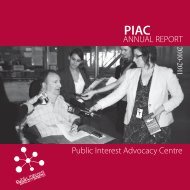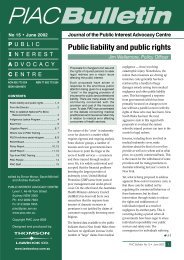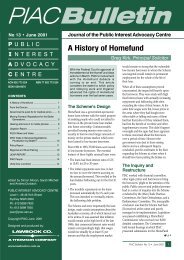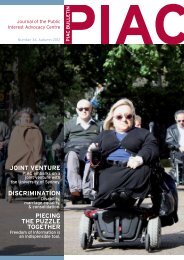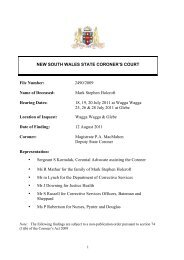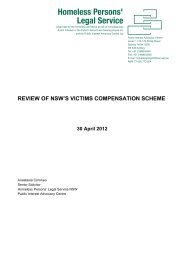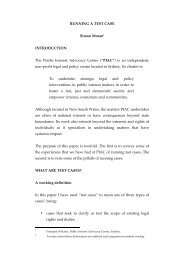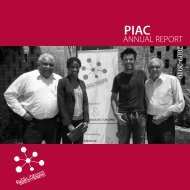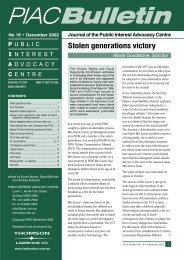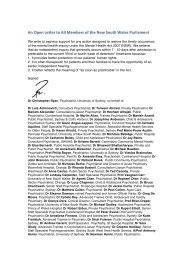Submission on Preliminary Framework and Approach - Australian ...
Submission on Preliminary Framework and Approach - Australian ...
Submission on Preliminary Framework and Approach - Australian ...
Create successful ePaper yourself
Turn your PDF publications into a flip-book with our unique Google optimized e-Paper software.
Network regulati<strong>on</strong> for all:<br />
<str<strong>on</strong>g>Submissi<strong>on</strong></str<strong>on</strong>g> to the AER’s preliminary<br />
<strong>Framework</strong> <strong>and</strong> approach paper for Ausgrid,<br />
Endeavour Energy <strong>and</strong> Essential Energy<br />
10 August 2012<br />
Oliver Derum, Policy Officer<br />
Energy + Water C<strong>on</strong>sumers’ Advocacy Program<br />
Level 7, 173-175 Phillip Street, Sydney NSW 2000 • DX 643 Sydney<br />
Ph<strong>on</strong>e: 61 2 8898 6500 • Fax: 61 2 8898 6555 • www.piac.asn.au
The Public Interest Advocacy Centre<br />
The Public Interest Advocacy Centre (PIAC) is an independent, n<strong>on</strong>-profit law <strong>and</strong> policy<br />
organisati<strong>on</strong> that works for a fair, just <strong>and</strong> democratic society, empowering citizens, c<strong>on</strong>sumers<br />
<strong>and</strong> communities by taking strategic acti<strong>on</strong> <strong>on</strong> public interest issues.<br />
PIAC identifies public interest issues <strong>and</strong>, where possible <strong>and</strong> appropriate, works co-operatively<br />
with other organisati<strong>on</strong>s to advocate for individuals <strong>and</strong> groups affected. PIAC seeks to:<br />
• expose <strong>and</strong> redress unjust or unsafe practices, deficient laws or policies;<br />
• promote accountable, transparent <strong>and</strong> resp<strong>on</strong>sive government;<br />
• encourage, influence <strong>and</strong> inform public debate <strong>on</strong> issues affecting legal <strong>and</strong> democratic<br />
rights; <strong>and</strong><br />
• promote the development of law that reflects the public interest;<br />
• develop <strong>and</strong> assist community organisati<strong>on</strong>s with a public interest focus to pursue the<br />
interests of the communities they represent;<br />
• develop models to resp<strong>on</strong>d to unmet legal need; <strong>and</strong><br />
• maintain an effective <strong>and</strong> sustainable organisati<strong>on</strong>.<br />
Established in July 1982 as an initiative of the (then) Law Foundati<strong>on</strong> of New South Wales, with<br />
support from the NSW Legal Aid Commissi<strong>on</strong>, PIAC was the first, <strong>and</strong> remains the <strong>on</strong>ly broadly<br />
based public interest legal centre in Australia. Financial support for PIAC comes primarily from<br />
the NSW Public Purpose Fund <strong>and</strong> the Comm<strong>on</strong>wealth <strong>and</strong> State Community Legal Services<br />
Program. PIAC also receives funding from Trade <strong>and</strong> Investment, Regi<strong>on</strong>al Infrastructure <strong>and</strong><br />
Services NSW for its work <strong>on</strong> energy <strong>and</strong> water, <strong>and</strong> from Allens Arthur Robins<strong>on</strong> for its<br />
Indigenous Justice Program. PIAC also generates income from project <strong>and</strong> case grants,<br />
seminars, c<strong>on</strong>sultancy fees, d<strong>on</strong>ati<strong>on</strong>s <strong>and</strong> recovery of costs in legal acti<strong>on</strong>s.<br />
Energy + Water C<strong>on</strong>sumers’ Advocacy Program<br />
This Program was established at PIAC as the Utilities C<strong>on</strong>sumers’ Advocacy Program in 1998<br />
with NSW Government funding. The aim of the program is to develop policy <strong>and</strong> advocate in the<br />
interests of low-income <strong>and</strong> other residential c<strong>on</strong>sumers in the NSW energy <strong>and</strong> water markets.<br />
PIAC receives policy input to the program from a community-based reference group whose<br />
members include:<br />
• Council of Social Service of NSW (NCOSS);<br />
• Combined Pensi<strong>on</strong>ers <strong>and</strong> Superannuants Associati<strong>on</strong> of NSW;<br />
• Park <strong>and</strong> Village Service;<br />
• Ethnic Communities Council NSW;<br />
• Rural <strong>and</strong> remote c<strong>on</strong>sumers;<br />
• Retirement Villages Residents Associati<strong>on</strong>;<br />
• the Physical Disability Council NSW; <strong>and</strong><br />
• Affiliated Residential Park Residents Associati<strong>on</strong>.
Introducti<strong>on</strong><br />
PIAC welcomes the opportunity to provide comment <strong>on</strong> the <strong>Australian</strong> Energy Regulator’s (AER)<br />
preliminary <strong>Framework</strong> <strong>and</strong> approach paper for Ausgrid, Endeavour Energy <strong>and</strong> Essential Energy<br />
(F&A paper), for the regulatory c<strong>on</strong>trol period from 1 July 2014 to 30 June 2019. PIAC’s<br />
comments focus <strong>on</strong> the mechanism to be used to regulate st<strong>and</strong>ard c<strong>on</strong>trol services in NSW.<br />
PIAC submits that there are three key factors that should be c<strong>on</strong>sidered when deciding <strong>on</strong> the<br />
appropriate c<strong>on</strong>trol mechanism. These are:<br />
• the overall outcome that the method of c<strong>on</strong>trol seeks to achieve;<br />
• the burden of risk for changes in c<strong>on</strong>sumpti<strong>on</strong> during regulatory periods; <strong>and</strong><br />
• the timing <strong>and</strong> magnitude of price fluctuati<strong>on</strong>s within the regulatory c<strong>on</strong>trol period.<br />
Distributi<strong>on</strong> network service providers (DNSPs) are natural m<strong>on</strong>opolies, due to the amount of<br />
infrastructure they require to deliver their services. However, the AER makes some distincti<strong>on</strong>s<br />
regarding which aspects of a DNSP’s business are to be regulated as m<strong>on</strong>opolies <strong>and</strong> which will<br />
be regulated differently or not at all. Core business functi<strong>on</strong>s, including the provisi<strong>on</strong> <strong>and</strong><br />
maintenance of the network, are designated as direct c<strong>on</strong>trol services <strong>and</strong> regulated as<br />
m<strong>on</strong>opolies. Direct c<strong>on</strong>trol services are further subdivided into st<strong>and</strong>ard c<strong>on</strong>trol services <strong>and</strong><br />
alternative c<strong>on</strong>trol services. Alternative c<strong>on</strong>trol services are those with a limited number of<br />
customers, in particular street lighting (where the customers are local government authorities).<br />
St<strong>and</strong>ard c<strong>on</strong>trol services are those that all, or most, customers use, including poles <strong>and</strong> wires,<br />
customer service <strong>and</strong> emergency resp<strong>on</strong>se—the vast majority of DNSP activity. PIAC’s<br />
comments in this submissi<strong>on</strong> relate to the regulati<strong>on</strong> of st<strong>and</strong>ard c<strong>on</strong>trol services <strong>on</strong>ly.<br />
The AER has the opti<strong>on</strong> to choose either a revenue cap or weighted average price cap (WAPC)<br />
as the c<strong>on</strong>trol mechanism for st<strong>and</strong>ard c<strong>on</strong>trol services. A revenue cap sets the total amount of<br />
revenue a DNSP can collect, while a WAPC sets the total weighted average price a DNSP can<br />
charge across its four tariff comp<strong>on</strong>ents: peak energy, other energy, fixed charge <strong>and</strong> capacity<br />
charge.<br />
In PIAC’s assessment, both c<strong>on</strong>trol mechanisms have strengths <strong>and</strong> weaknesses. Having<br />
analysed the prospect of either c<strong>on</strong>trol mechanism to deliver the best results for c<strong>on</strong>sumers,<br />
PIAC c<strong>on</strong>tends that a revenue cap is more likely to deliver favourable outcomes in the key<br />
c<strong>on</strong>siderati<strong>on</strong>s outlined above. However, if a method can be found to deliver the same outcomes<br />
through a WAPC, PIAC would also c<strong>on</strong>sider supporting such an approach.<br />
Limiting cost-recovery to the efficient level<br />
PIAC takes the view that the aim of DNSP regulati<strong>on</strong> should be to keep prices as low as possible<br />
for c<strong>on</strong>sumers. Residential c<strong>on</strong>sumers, especially those <strong>on</strong> low or fixed incomes, cannot be<br />
expected to absorb network costs above efficient levels, given these costs c<strong>on</strong>stitute up to 57%<br />
of residential electricity bills in NSW. 1 For this reas<strong>on</strong>, PIAC supports the AER’s positi<strong>on</strong> that in<br />
deciding which c<strong>on</strong>trol mechanism to adopt, the AER should c<strong>on</strong>sider whether that mechanism<br />
‘provides DNSPs with an opportunity to recover efficient costs, while limiting revenue recovery<br />
1<br />
For c<strong>on</strong>sumers in the Essential Energy distributi<strong>on</strong> area. Independent Pricing <strong>and</strong> Regulatory Tribunal, Changes<br />
in regulated electricity retail prices from 1 July 2012 – Final report, 2012, 10.<br />
2 • Public Interest Advocacy Centre • Network regulati<strong>on</strong> for all
above such costs’. 2 PIAC also holds the view that DNSP costs are largely fixed <strong>and</strong> determined<br />
by peak dem<strong>and</strong>, with sales volume having <strong>on</strong>ly a minimal impact.<br />
PIAC c<strong>on</strong>siders that the risk of revenue recovery above efficient levels is more significant under a<br />
WAPC than a revenue cap. In the F&A paper, the AER notes that Victorian DNSPs recovered<br />
revenue 8.28% above efficient levels over the 2006-2010 regulatory c<strong>on</strong>trol period through<br />
WAPC regulati<strong>on</strong>. This meant that the burden <strong>on</strong> Victorian c<strong>on</strong>sumers was $568 milli<strong>on</strong> higher<br />
than should have been the case. 3 Over recovery under a WAPC occurs when sales volumes<br />
increase above forecasts. The value of the WAPC is calculated by dividing the total cost of<br />
providing network services by the forecast volume to be carried by the network. This means that<br />
when sales increase above the original forecast—but total cost increases are insignificant or at<br />
least increase at a lower rate—DNSPs are able to recover costs above the efficient level. A<br />
WAPC therefore provides an undesirable or perverse incentive <strong>on</strong> DNSPs to underestimate their<br />
projected sales. This risk is heightened by the complexity of forecasting dem<strong>and</strong> accurately. The<br />
F&A paper states that ‘while the AER rigorously assesses the forecasts proposed by the DNSPs,<br />
the AER is c<strong>on</strong>cerned with the overall accuracy of volume forecasts’. 4 A revenue cap removes<br />
this perverse incentive, because DNSPs are given a total amount of revenue that they can<br />
recover, set at the level required to run their networks at efficient costs.<br />
It should also be noted that under a WAPC, prices for all five years of a regulatory c<strong>on</strong>trol period<br />
are set at <strong>on</strong>e time. Due to the nature of forecasting, the risks of inaccurate forecasts increase for<br />
each year after the time the forecasts were made. Inaccurate forecasts under a WAPC can also<br />
result in large fluctuati<strong>on</strong>s between regulatory c<strong>on</strong>trol periods. This issue is discussed in more<br />
detail below.<br />
The burden of risk for changes in c<strong>on</strong>sumpti<strong>on</strong> during regulatory<br />
periods<br />
A revenue cap <strong>and</strong> WAPC c<strong>on</strong>trol mechanism pose different risks for DNSPs <strong>and</strong> c<strong>on</strong>sumers<br />
when the volume of total dem<strong>and</strong> is changing within a regulatory c<strong>on</strong>trol period. Under a WAPC,<br />
networks carry the risk of a decline in volume, because they are not able to increase their overall<br />
price cap to maintain revenue in light of declining sales. At the same time, c<strong>on</strong>sumers carry the<br />
risk associated with increasing sales. This is because increasing sales, particularly of <strong>on</strong>e<br />
comp<strong>on</strong>ent of the WAPC, give DNSPs an opportunity to reweight the price cap towards that<br />
service <strong>and</strong> recover revenue above efficient costs.<br />
Under a revenue cap, c<strong>on</strong>sumers bear the risk of a reducti<strong>on</strong> in overall dem<strong>and</strong>. When overall<br />
revenue is capped but volume is falling, DNSPs are able to increase prices in order to reach their<br />
revenue cap despite a lower level of sales. C<strong>on</strong>versely, if volumes increase, DNSPs are<br />
c<strong>on</strong>strained in their ability to immediately increase prices in resp<strong>on</strong>se to increased dem<strong>and</strong>, <strong>and</strong><br />
must wait until the cap is re-calculated at the end of each year (see below).<br />
Ideally, the risk associated with a decrease in volume should not be borne by c<strong>on</strong>sumers.<br />
However, PIAC c<strong>on</strong>siders that the negative effect of c<strong>on</strong>sumers bearing this risk under a revenue<br />
cap must be weighed against that of over-recovery by DNSPs above efficient levels under a<br />
2<br />
3<br />
4<br />
AER, <strong>Framework</strong> <strong>and</strong> approach paper: Ausgrid, Endeavour Energy <strong>and</strong> Essential Energy–Regulatory c<strong>on</strong>trol<br />
period commencing 1 July 2014 (<strong>Preliminary</strong> positi<strong>on</strong>s), 2012, 54.<br />
Ibid 55.<br />
Ibid.<br />
Public Interest Advocacy Centre • Network regulati<strong>on</strong> for all • 3
WAPC. The risk of this occurring under a WAPC is further heightened due to the need to make<br />
l<strong>on</strong>ger-range forecasts covering a whole five-year period <strong>and</strong> the challenge of doing so<br />
accurately.<br />
Price stability<br />
The frequency <strong>and</strong> magnitude of price fluctuati<strong>on</strong>s differ under a revenue cap versus a WAPC<br />
c<strong>on</strong>trol mechanism. Under a revenue cap, yearly adjustments are made based <strong>on</strong> whether<br />
revenue in the previous year has been over or under recovered (known as the ‘over or under<br />
account’). The over or under account is then incorporated into the following year’s cap, meaning<br />
total revenue remains capped over the whole of the regulatory c<strong>on</strong>trol period. While these<br />
adjustments present potential price fluctuati<strong>on</strong>s for c<strong>on</strong>sumers, PIAC, like the AER, c<strong>on</strong>siders<br />
that these could be effectively moderated by introducing tolerance limits for the adjustment in any<br />
<strong>on</strong>e year. 5 PIAC also notes that yearly price adjustments are a regular feature of st<strong>and</strong>ard<br />
c<strong>on</strong>tracts in NSW, <strong>and</strong> changes in network are part of these price movements.<br />
The two c<strong>on</strong>trol mechanisms also create different fluctuati<strong>on</strong>s when volumes are decreasing.<br />
Under a revenue cap, volume forecasts are updated annually, in order to calculate the price of a<br />
single unit of c<strong>on</strong>sumpti<strong>on</strong>. Where volumes are decreasing, prices under a revenue cap are<br />
slowly adjusted upwards each year. In c<strong>on</strong>trast, under a WAPC, prices are set for five years at<br />
the beginning of each regulatory period. While this provides price stability within each regulatory<br />
period, if c<strong>on</strong>sumpti<strong>on</strong> volumes decrease over a number of years, all necessary adjustments will<br />
be made in <strong>on</strong>e hit at the start of the next regulatory c<strong>on</strong>trol period.<br />
PIAC submits that vulnerable c<strong>on</strong>sumers are better served by smaller price adjustments that<br />
more accurately reflect real-time costs. If dem<strong>and</strong> forecasts are reassessed annually, c<strong>on</strong>sumers<br />
are more likely to pay closer to the efficient cost of delivering network services <strong>and</strong> not face five<br />
years worth of adjustment for forecast inaccuracy at the start of the next regulatory c<strong>on</strong>trol period.<br />
More gradual price movements also allow c<strong>on</strong>sumers to make measured adjustments to<br />
c<strong>on</strong>sumpti<strong>on</strong> in other areas when necessary, rather than being forced to make dramatic cuts at<br />
the start of a regulatory c<strong>on</strong>trol period.<br />
C<strong>on</strong>clusi<strong>on</strong><br />
Vulnerable c<strong>on</strong>sumers <strong>on</strong> low <strong>and</strong> fixed incomes cannot be expected to absorb more than<br />
efficient network costs as part of paying for the essential service of electricity. PIAC therefore<br />
submits that the c<strong>on</strong>trol mechanism for st<strong>and</strong>ard c<strong>on</strong>trol services should limit the potential for<br />
DNSPs to recover revenue above efficient costs. In additi<strong>on</strong>, the c<strong>on</strong>trol mechanism should<br />
facilitate gradual price adjustments, rather than large jumps between periods. PIAC c<strong>on</strong>siders<br />
that these are both characteristics of revenue cap regulati<strong>on</strong>. However, if the same outcomes can<br />
be achieved through a WAPC approach, PIAC remains open to the possibility of such an<br />
arrangement being adopted in NSW.<br />
PIAC also notes that there are risks to c<strong>on</strong>sumers under both approaches. Under a revenue cap,<br />
c<strong>on</strong>sumers bear the risk of increasing prices if dem<strong>and</strong> falls. Under a WAPC, there is the risk of<br />
DNSPs over-recovering costs above efficient levels, due to tariff reweighting, particularly when<br />
dem<strong>and</strong> grows above forecast levels. Because forecasts for a whole five-year period are made at<br />
the start of a price determinati<strong>on</strong> utilising a WAPC approach, PIAC believes that the risk of cost<br />
over-recovery outweighs those of increasing prices under a revenue cap.<br />
5<br />
Ibid 60.<br />
4 • Public Interest Advocacy Centre • Network regulati<strong>on</strong> for all
Facilitating the best outcomes for c<strong>on</strong>sumers will necessitate a thorough analysis of all costs <strong>and</strong><br />
forecasts proposed by DNSPs so that NSW c<strong>on</strong>sumers <strong>on</strong>ly face the efficient costs of running an<br />
electricity network. It is PIAC's str<strong>on</strong>g view that the AER generally, <strong>and</strong> the team working <strong>on</strong> the<br />
NSW Network price determinati<strong>on</strong> process specifically, must be suitably resourced to undertake<br />
this important task.<br />
Public Interest Advocacy Centre • Network regulati<strong>on</strong> for all • 5




